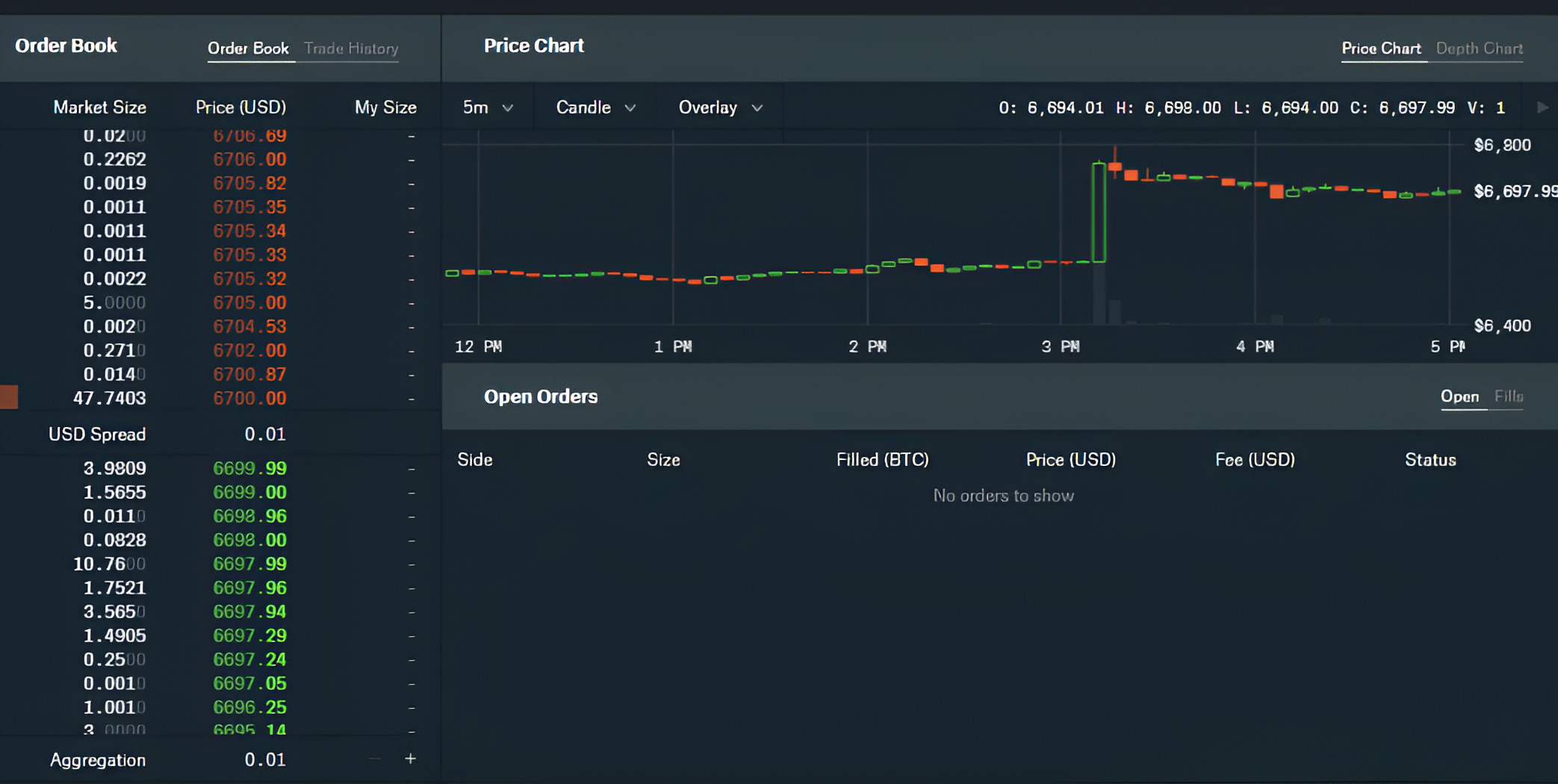Introduction
Welcome to the exciting world of Bitcoin trading! With the rise in popularity of cryptocurrencies, more and more people are exploring the opportunities in this digital asset market. Bitcoin, the first and most well-known cryptocurrency, has gained significant attention and has become a sought-after investment option.
Bitcoin trading involves buying and selling Bitcoin in order to take advantage of the price fluctuations. The goal is to buy Bitcoin at a lower price and sell it at a higher price, making a profit in the process. However, it is essential to understand that Bitcoin trading is a highly volatile and speculative market, which means that the price can change rapidly and unpredictably.
In this comprehensive guide, we will walk you through the key steps to start your Bitcoin trading journey. We will cover everything from setting up a Bitcoin wallet and choosing a reputable Bitcoin exchange to developing a trading strategy and managing risks.
Whether you are a beginner or have some experience in trading, this guide will provide you with the insights and knowledge you need to make informed decisions and navigate the Bitcoin market effectively. Remember, trading involves both potential rewards and risks, so it is crucial to approach it with a disciplined mindset and a willingness to learn.
So, if you are ready to dive into the world of Bitcoin trading, let’s get started!
Understanding Bitcoin and Cryptocurrency Trading
In order to be successful in Bitcoin trading, it is important to have a solid understanding of Bitcoin and how cryptocurrency trading works. So, let’s start by explaining the basics.
Bitcoin is a decentralized digital currency that was created in 2009 by an anonymous person or group of people using the pseudonym Satoshi Nakamoto. It operates on a technology called blockchain, which is a distributed ledger that records all Bitcoin transactions. Unlike traditional fiat currencies, such as the US dollar or the Euro, Bitcoin is not controlled by any central authority, such as a government or financial institution.
Cryptocurrency trading involves buying and selling digital currencies, such as Bitcoin, in order to make a profit. Similar to stock trading, the goal is to take advantage of the price fluctuations and buy low and sell high. However, unlike traditional stock markets, cryptocurrency markets are open 24/7, allowing traders to engage in trading activities at any time.
There are two primary methods of cryptocurrency trading: spot trading and derivatives trading. Spot trading involves buying or selling cryptocurrencies for immediate delivery, where traders own the physical asset. On the other hand, derivatives trading involves trading contracts that derive their value from an underlying cryptocurrency, allowing traders to speculate on price movements without actually owning the cryptocurrency itself.
One of the reasons why Bitcoin and cryptocurrencies have gained popularity among traders is the potential for high returns. The price of Bitcoin can be highly volatile, which means that the value can significantly increase or decrease in a short period of time. While this volatility presents opportunities for profit, it also comes with increased risk.
It is important to note that trading cryptocurrencies carries certain risks. The cryptocurrency market can be influenced by various factors, including market sentiment, regulatory developments, technological advancements, and macroeconomic trends. Therefore, it is crucial to conduct thorough research, stay updated with market news and trends, and understand the risks involved before engaging in cryptocurrency trading.
Now that you understand the basics of Bitcoin and cryptocurrency trading, the next step is to learn how to get started with Bitcoin trading. We will explore this in the following section.
Getting Started with Bitcoin Trading
If you’re ready to start your Bitcoin trading journey, this section will guide you through the essential steps to get started.
1. Set Up a Bitcoin Wallet: The first step is to set up a Bitcoin wallet, which is a digital wallet that allows you to store, send, and receive Bitcoin securely. There are different types of wallets available, including hardware wallets, software wallets, and online wallets. Research and choose a wallet that suits your needs and provides a high level of security.
2. Choose a Bitcoin Exchange: Once you have a wallet, you will need to choose a reputable Bitcoin exchange to buy and sell Bitcoin. Look for an exchange that offers a user-friendly interface, strong security measures, and competitive fees. Some popular Bitcoin exchanges include Coinbase, Binance, and Kraken.
3. Complete the Verification Process: Most Bitcoin exchanges require users to go through a verification process to comply with Know Your Customer (KYC) and Anti-Money Laundering (AML) regulations. This typically involves providing personal identification documents, such as a passport or driver’s license, and proof of address, such as a utility bill or bank statement.
4. Deposit Funds: After completing the verification process, you can deposit funds into your Bitcoin exchange account. This can usually be done using various payment methods, including bank transfers, credit/debit cards, or even cryptocurrency deposits.
5. Develop a Trading Strategy: It is crucial to develop a trading strategy before you start trading. Consider factors such as your risk tolerance, investment goals, and time commitment. Decide whether you want to engage in day trading, swing trading, or long-term holding. A well-defined strategy can help you make informed decisions and stay disciplined.
6. Learn Technical Analysis: Technical analysis involves studying historical price data and using various indicators to predict future price movements. Learn the basics of technical analysis to identify trends, support and resistance levels, and potential entry and exit points for your trades.
7. Practice and Learn: Before risking real money, it is advisable to practice trading with virtual money using a demo account provided by some exchanges. This allows you to familiarize yourself with the trading platform, test your strategies, and gain confidence before trading with real funds.
8. Manage Risks: Risk management is crucial in trading. Set a stop-loss order to limit potential losses, and consider using a take-profit order to secure profits. It’s also important to diversify your investments and not risk more than you can afford to lose.
9. Stay Informed: Stay updated with the latest news, market trends, and regulatory developments in the cryptocurrency space. This information can help you make informed decisions and adapt your trading strategies accordingly.
10. Stay Disciplined: Finally, it’s essential to stay disciplined and control your emotions while trading. Stick to your trading plan and avoid making impulsive decisions based on short-term market fluctuations.
Now that you have a clear understanding of how to get started with Bitcoin trading, it’s time to delve deeper into the intricacies of creating a trading strategy in the next section.
Setting Up a Bitcoin Wallet
A Bitcoin wallet is a digital wallet that allows you to store, send, and receive Bitcoin securely. It is a crucial component of Bitcoin trading as it provides a secure place to hold your Bitcoin and facilitates transactions. Here’s a step-by-step guide on setting up a Bitcoin wallet:
1. Choose a Wallet Type: There are different types of Bitcoin wallets available, each with its own advantages and security features. The main types include:
- Hardware Wallets: These are physical devices that securely store your Bitcoin offline, providing the highest level of security.
- Software Wallets: These are applications that can be installed on your computer or mobile device. They offer a balance between security and convenience.
- Online Wallets: These are web-based wallets that are accessible from any device with an internet connection. They are convenient but may be more susceptible to hacking risks.
2. Research and Select a Wallet: Take the time to research different wallet options and choose the one that best suits your needs. Consider factors such as security features, ease of use, compatibility with your devices, and community reviews.
3. Download and Install the Wallet: If you opt for a software wallet, visit the official website of the wallet provider and download the appropriate version for your device. Follow the installation instructions provided.
4. Create a New Wallet: Once the wallet is installed, open it and create a new wallet. You will likely be asked to choose a strong password or PIN code to protect your wallet. Ensure that you choose a unique and secure password that you can remember.
5. Backup Your Wallet: It is crucial to create a backup of your wallet to ensure that you can recover your funds in case your device is lost or damaged. Most wallets provide an option to create a backup phrase or seed, which is a sequence of words that can be used to restore your wallet.
6. Store Your Backup Safely: Make multiple copies of your backup phrase or seed and store them in secure locations. Consider using offline storage methods, such as writing it down on paper or engraving it on a metal plate, to protect against digital threats.
7. Receive and Send Bitcoin: Your Bitcoin wallet will provide you with a unique Bitcoin address. This address is what you share with others to receive Bitcoin. To send Bitcoin, you will need the recipient’s Bitcoin address. Copy and paste the addresses or use the wallet’s QR code functionality for convenience.
8. Enable Additional Security Measures: Depending on your wallet type, you may be able to enable additional security features, such as two-factor authentication or biometric authentication. These measures enhance the security of your wallet and protect your funds.
9. Keep Your Wallet Up to Date: Wallet providers regularly release updates to improve security and add new features. Make sure to update your wallet to the latest version to benefit from these enhancements.
Remember, the security of your Bitcoin wallet is of utmost importance. Take the necessary precautions to protect your wallet and keep your private keys secure. By setting up a reliable and secure Bitcoin wallet, you are ready to move on to the next step of choosing a Bitcoin exchange.
Choosing a Bitcoin Exchange
Choosing the right Bitcoin exchange is an essential step in your Bitcoin trading journey. A Bitcoin exchange is a digital marketplace where you can buy, sell, and trade Bitcoin and other cryptocurrencies. Here’s a guide to help you choose a reputable and reliable Bitcoin exchange:
1. Reputation and Track Record: Look for an exchange with a good reputation and a solid track record in the industry. Research the exchange’s history, customer reviews, and any security incidents or regulatory actions they may have faced.
2. Security Measures: Security should be a top priority when choosing a Bitcoin exchange. Look for exchanges that implement strong security measures, such as two-factor authentication (2FA), encryption, cold storage, and regular security audits.
3. User-Friendly Interface: Consider an exchange that offers a user-friendly and intuitive interface. This will make it easier for you to navigate the platform, manage your funds, and execute trades effectively.
4. Liquidity: Liquidity refers to the ease with which you can buy or sell Bitcoin on the exchange. Choose an exchange with high liquidity, as this ensures that there are enough buyers and sellers for efficient trading.
5. Supported Payment Methods: Check if the exchange supports the payment methods you intend to use. Common options include bank transfers, credit/debit cards, and other cryptocurrencies. Ensure that the exchange supports your preferred currency and offers competitive fees for deposits and withdrawals.
6. Customer Support: Look for exchanges that offer reliable and responsive customer support. This is important in case you encounter any issues or have questions regarding your trading activities.
7. Regulations and Compliance: Consider the exchange’s compliance with regulations and whether it operates in your country or region. Exchanges that adhere to strict regulatory standards provide an added layer of trust and security.
8. Trading Fees: Take into account the exchange’s fee structure for trading. Exchanges typically charge fees for trades, deposits, and withdrawals. Compare fee structures among different exchanges to ensure you choose one that offers competitive rates.
9. Trading Options and Features: Consider the trading options and features offered by the exchange. This includes the types of orders supported (market, limit, stop-loss, etc.), available trading pairs, and any advanced trading features or tools provided.
10. Mobile App: If you prefer trading on the go, check if the exchange has a mobile app available. A mobile app allows you to monitor your trades, access your account, and execute trades conveniently from your smartphone.
11. Reputation of the Management Team: It can be helpful to research the management team behind the exchange. Look for experienced professionals with a background in the cryptocurrency industry or financial markets.
By considering these factors, you can narrow down your options and choose a Bitcoin exchange that aligns with your trading needs and preferences. Remember to conduct thorough research and take the time to evaluate different exchanges before making your final decision.
Creating a Trading Strategy
A well-defined trading strategy is crucial in Bitcoin trading as it helps guide your decision-making process and maximizes your chances of success. Here are the key steps to create an effective trading strategy:
1. Define Your Goals: Start by identifying your trading goals. Are you looking to make short-term profits or aiming for long-term growth? Understanding your goals will help shape your trading strategy and determine your risk tolerance.
2. Determine Your Risk Tolerance: Assess your risk tolerance level, which is the amount of risk you are willing to take on. This will influence your trading decisions and the amount of capital you are comfortable risking in each trade.
3. Choose Your Trading Style: Decide which trading style aligns with your goals and personality. Popular styles include day trading, where trades are opened and closed within the same day, and swing trading, where positions are held for several days or weeks. Choose a style that suits your schedule, available time, and risk tolerance.
4. Develop Entry and Exit Strategies: Outline clear criteria for entering and exiting trades. This may involve technical analysis indicators, such as moving averages or support and resistance levels, or fundamental analysis based on market news and events. Having predefined entry and exit points helps remove emotions from your trading decisions.
5. Set Profit Targets and Stop Loss Levels: Determine your profit targets for each trade, as well as the maximum loss you are willing to accept. This allows you to have a clear risk-to-reward ratio and ensures you have a plan in place for both profitable and losing trades.
6. Use Risk Management Techniques: Implement risk management techniques to protect your capital. This may involve position sizing, where you allocate a specific percentage of your capital to each trade, and utilizing stop-loss orders to automatically exit a trade if it moves against you.
7. Test and Evaluate Your Strategy: Before risking real money, test your trading strategy in a simulated or demo account. This allows you to analyze the performance of your strategy without the risk of losing actual funds. Keep track of your trades and evaluate the profitability and consistency of your strategy.
8. Adjust and Improve: Evaluate the performance of your strategy regularly and make necessary adjustments. Analyze your winning and losing trades to identify patterns and potential areas for improvement. Continuously learning and adapting your strategy is essential for long-term success in Bitcoin trading.
9. Stay Disciplined: Stick to your trading strategy and avoid making impulsive decisions based on short-term market fluctuations. Emotional trading can lead to poor decision-making and unnecessary risks. Have confidence in your strategy and trust the process.
10. Keep Learning: Stay updated with market trends, news, and technological advancements in the cryptocurrency space. Continuously educate yourself on new trading techniques and strategies to refine your skills and stay ahead of the curve.
Remember, no trading strategy guarantees profits, and losses are a part of the trading process. However, a well-thought-out and disciplined trading strategy can increase your chances of success in the Bitcoin trading market.
Learning Technical Analysis
Technical analysis is a vital tool for Bitcoin traders as it helps identify trends, patterns, and potential trading opportunities based on historical price data. Here are the key steps to learning and utilizing technical analysis effectively:
1. Understand the Basics: Start by familiarizing yourself with the basic concepts of technical analysis. Learn about candlestick charts, price indicators, support and resistance levels, chart patterns, and trend lines. These are the foundation of technical analysis and serve as building blocks for more advanced analysis.
2. Study Different Indicators: Explore and study various technical indicators such as moving averages, Relative Strength Index (RSI), Moving Average Convergence Divergence (MACD), and Bollinger Bands. Each indicator provides unique insights into market trends, momentum, and potential overbought or oversold conditions.
3. Analyze Price Patterns: Price patterns, such as triangles, double tops or bottoms, head and shoulders, and flags, can provide valuable information about potential price movements. Study these patterns and understand their implications to identify potential trade setups.
4. Identify Support and Resistance Levels: Support and resistance levels are price levels at which the market tends to pause or reverse. Identifying these levels can help you predict potential entry and exit points for your trades. Use previous price highs and lows, as well as horizontal trendlines, to identify significant support and resistance levels.
5. Use Multiple Time Frames: Analyze Bitcoin price movements across different timeframes. Short-term traders may focus on intraday charts and use shorter timeframes like 1-hour or 15-minute intervals. Long-term investors may prefer daily or weekly charts. Analyzing multiple time frames can provide a broader perspective and help confirm trends and patterns.
6. Practice on Historical Data: Utilize historical price data to practice your technical analysis skills. Analyze historical charts and try to identify patterns and trends that could have resulted in profitable trades. This practice will help you develop your analytical skills and gain confidence in your ability to interpret price movements.
7. Combine Technical and Fundamental Analysis: While technical analysis focuses on price movements, combining it with fundamental analysis can provide a more comprehensive understanding of the market. Consider the impact of news events, market sentiment, and other fundamental factors that may influence Bitcoin’s price.
8. Stay Updated with Market News: Stay informed about market news and events that could impact Bitcoin’s price. Significant news, regulatory announcements, or global economic developments can cause volatility in the cryptocurrency market. Being aware of these factors can help you adjust your trading strategies accordingly.
9. Utilize Trading Tools and Platforms: Take advantage of various technical analysis tools and platforms available in the crypto market. Many trading platforms offer built-in technical analysis tools and signals that can enhance your analysis and streamline your trading process.
10. Continuously Learn and Improve: The field of technical analysis is vast and constantly evolving. Stay curious and continue learning new techniques, experimenting with different indicators, and refining your analysis skills. Continuously improving your technical analysis abilities is key to becoming a proficient trader.
Remember, technical analysis is subjective and relies on interpreting historical price data. It is important to combine technical analysis with risk management strategies and exercise caution when making trading decisions.
Risk Management and Profit-Taking Strategies
Risk management is a critical aspect of Bitcoin trading that helps protect your capital and minimize potential losses. Additionally, implementing profit-taking strategies ensures you secure profits and capitalize on successful trades. Here are some important considerations for managing risks and setting profit-taking strategies:
1. Position Sizing: Determine the appropriate amount of capital to allocate to each trade based on your risk tolerance. Consider using a percentage of your total capital, such as 1% or 2%, as a general guideline. This helps prevent overexposure to individual trades and safeguards against significant losses.
2. Stop-Loss Orders: Set stop-loss orders to automatically exit a trade if the price moves against you. This ensures that losses are limited and prevents emotions from impacting your decision-making. Place stop-loss orders at levels that align with your risk tolerance and technical analysis.
3. Take-Profit Orders: Similarly, set take-profit orders to secure profits when the price reaches a predetermined target. This allows you to lock in gains and avoid the temptation to hold onto a position for too long, potentially risking a reversal in price.
4. Trailing Stop-Loss Orders: Consider using trailing stop-loss orders, which automatically adjust your stop-loss level as the price moves in your favor. This allows you to capture more significant profits if the price continues to rise while still protecting your gains if there is a reversal.
5. Risk-Reward Ratio: Evaluate the risk-to-reward ratio for each trade. Ideally, aim for a ratio where the potential reward is greater than the potential risk. For example, if you are willing to risk $100 on a trade, your profit target should ideally be $200 or more.
6. Diversification: Spread your trading capital across different cryptocurrencies or trading pairs. Diversification helps mitigate risks by reducing the impact of losses on your overall portfolio. Consider including assets with different risk profiles to balance potential gains and losses.
7. Emotional Control: Emotions can cloud judgment and lead to impulsive trading decisions. Practice emotional control and avoid making trades based on fear, greed, or FOMO (fear of missing out). Stick to your trading plan and strategy, and make informed decisions based on analysis and risk management principles.
8. Regularly Review and Adjust: Continuously monitor and review your trading performance. Assess the effectiveness of your risk management and profit-taking strategies. If necessary, make adjustments to improve your approach and align it with your trading goals.
9. Maintain Realistic Expectations: Set realistic goals and expectations for your trading endeavors. Understand that losses are a part of trading and that consistent profitability takes time and experience. Avoid chasing unrealistic profits or engaging in overly risky strategies.
10. Seek Expert Advice: Consider consulting with experienced traders or seeking guidance from professionals to gain insights and exchange ideas. Engaging with a community of traders can provide valuable perspectives and help refine your risk management and profit-taking strategies.
Remember, risk management is crucial to preserving your trading capital and ensuring long-term success. By implementing effective risk management techniques and profit-taking strategies, you can navigate the Bitcoin market with greater confidence and discipline.
Setting Realistic Goals and Expectations
Setting realistic goals and expectations is crucial for successful Bitcoin trading. It helps you maintain focus, manage risk effectively, and stay motivated throughout your trading journey. Here are some key considerations when setting goals and expectations:
1. Understand the Volatility: Bitcoin and the cryptocurrency market can be highly volatile, with rapid and significant price fluctuations. It is important to recognize and accept this volatility when setting goals and expectations. Be prepared for both gains and losses, and avoid expecting consistent profits on every trade.
2. Educate Yourself: Take the time to educate yourself about Bitcoin, cryptocurrency trading, and market dynamics. Understand the factors that influence price movements, such as market sentiment, regulatory developments, technological advancements, and global economic conditions. This knowledge will help you set more informed and realistic goals.
3. Start with Small, Achievable Goals: Begin with small, achievable goals to build your confidence and experience. For example, aim for a specific percentage return on your initial trading capital or a certain number of successful trades. Celebrating these milestones will keep you motivated and help you progress towards larger goals over time.
4. Consider Timeframes: Determine the timeframe for your trading goals. Decide whether you are aiming for short-term gains with day trading, medium-term growth with swing trading, or long-term accumulation with investment strategies. Different timeframes require different strategies and may yield different levels of profitability.
5. Assess Your Risk Tolerance: Your risk tolerance and available trading capital play a significant role in setting realistic goals. Understand how much capital you are willing to risk and be honest about your comfort level with potential losses. Setting goals that align with your risk tolerance will help you manage stress and make better trading decisions.
6. Avoid Unrealistic Profit Targets: While it is natural to aim for profits, avoid setting unrealistic profit targets that may be unattainable in the current market conditions. Base your profit targets on historical price movements and technical analysis. Keep in mind that consistent profitability often takes time and experience.
7. Plan for Market Cycles: Bitcoin and the cryptocurrency market go through cycles of ups and downs. During bull markets, prices tend to rise, and it may be easier to achieve higher returns. However, bear markets can present challenges with declining prices. Factor in these market cycles when setting your goals and adjust your strategies accordingly.
8. Regularly Review and Adjust: Regularly review your goals and trading performance and make necessary adjustments. Evaluate your progress, profitability, and risk management practices. If needed, modify your goals to align with changing market conditions and personal circumstances.
9. Focus on Learning and Improvement: While setting goals is important, remember that trading is a continuous learning process. Emphasize personal growth, improving your trading skills, and gaining experience rather than just focusing on financial targets. Seek opportunities to expand your knowledge, experiment with different strategies, and learn from both successes and failures.
10. Manage Your Emotions: Emotional control is essential in trading. Keep your emotions in check and avoid making impulsive decisions based on fear, greed, or market noise. Stick to your trading plan and remain disciplined, as this will contribute to setting realistic goals and achieving consistent results.
Setting realistic goals and expectations is key to long-term success in Bitcoin trading. By understanding the market dynamics, managing risk effectively, and continuously learning and improving, you can navigate the challenges and opportunities of the cryptocurrency market with confidence and resilience.
Staying Updated with Market News and Trends
Staying informed about market news and trends is crucial for effective decision-making in Bitcoin trading. The cryptocurrency market is dynamic and influenced by various factors, making it essential to stay updated with the latest developments. Here are some key considerations to stay informed:
1. Follow Reliable News Sources: Identify reputable news sources that specialize in reporting on cryptocurrencies and the blockchain industry. Trusted news outlets, cryptocurrency websites, and reputable financial publications can provide valuable insights into market trends, regulatory changes, and technological advancements.
2. Set up Price Alerts: Utilize price alert tools or notifications provided by trading platforms to stay informed about significant price movements. Set alerts for specific price levels or percentage changes to monitor potential entry or exit opportunities in the market.
3. Engage in Online Communities: Join online communities, forums, and social media groups focusing on cryptocurrencies and Bitcoin trading. Participating in discussions allows you to interact with like-minded individuals, share knowledge, and stay updated on the latest news and trends in the industry.
4. Follow Influential Figures: Identify influential figures in the cryptocurrency space, such as industry experts, influential traders, thought leaders, and cryptocurrency project founders. Follow them on social media platforms or subscribe to their newsletters to gain valuable insights and stay updated with their views on the market.
5. Utilize Trading Platforms and Tools: Many trading platforms provide built-in news feeds and market analysis tools. These features can help you stay updated with the latest market news, analysis, and trends. Additionally, consider utilizing cryptocurrency-focused news aggregators or market data platforms.
6. Monitor Regulatory Developments: Keep track of regulatory developments and government actions that may impact the cryptocurrency market. Changes in regulations can affect market sentiment, liquidity, and the legal landscape for cryptocurrencies. Stay informed about potential regulatory risks and how they might impact your trading activities.
7. Analyze Technical and Fundamental Analysis: Study technical analysis charts and indicators to identify trends, patterns, and possible price movements. Additionally, consider fundamental analysis by examining the underlying factors that can impact the value of Bitcoin, such as technological advancements, partnerships, and adoption by businesses or governments.
8. Attend Webinars and Conferences: Participate in webinars, virtual conferences, and seminars related to Bitcoin trading and cryptocurrencies. These events often provide insights from experts, market analysis, and networking opportunities, allowing you to stay updated and expand your knowledge base.
9. Keep an Eye on Market Sentiment: Monitor market sentiment and investor behavior. Sentiment indicators, such as social media sentiment analysis or market sentiment indexes, can give you an idea of the overall mood and anticipation in the market. Understanding market sentiment can help you make more informed trading decisions.
10. Continuously Learn and Adapt: The cryptocurrency market evolves rapidly, and new trends and information emerge regularly. Stay curious and invest time in learning about emerging technologies, trends, and trading strategies. Continuously educate yourself to adapt to the changing market conditions and gain a competitive edge.
By staying updated with market news and trends, you can make more informed decisions, identify potential opportunities, and navigate the dynamic Bitcoin trading landscape with confidence.
Practicing and Improving Trading Skills
Practicing and improving trading skills is essential for becoming a successful Bitcoin trader. It is through practice and continuous learning that traders can enhance their abilities and make better-informed decisions. Here are some key steps to practice and improve your trading skills:
1. Start with a Demo Account: Many exchanges and trading platforms offer demo accounts that allow you to practice trading with virtual money. Utilize these accounts to familiarize yourself with the platform’s features, test different strategies, and gain experience without risking real funds.
2. Paper Trading: Another practice method is paper trading, where you simulate trades on paper or in a spreadsheet without using real money. This approach allows you to track the performance of your trading strategies, identify areas for improvement, and analyze the impact of different trading decisions.
3. Reflect and Analyze: After each trade, take the time to reflect on the outcomes. Analyze the reasons behind your trading decisions and evaluate the effectiveness of your strategies. Learn from both your successful trades and your losses, identifying patterns and areas for improvement.
4. Keep a Trading Journal: Maintaining a trading journal can be invaluable for tracking your progress. Record details of your trades, including entry and exit points, trade duration, profit or loss, and any factors that influenced your decisions. Reviewing your journal regularly can help you identify strengths and weaknesses in your trading approach.
5. Learn from the Experts: Seek out reputable trading resources, books, courses, or educational materials to deepen your understanding of trading concepts and techniques. Learn from experienced traders who can offer valuable insights and share their strategies and experiences.
6. Backtest Your Strategies: Use historical price data to backtest your trading strategies. By applying your strategies to past data, you can assess their potential effectiveness and identify any shortcomings or areas for improvement.
7. Join Trading Communities: Engage with trading communities and participate in discussions with fellow traders. Sharing knowledge, exchanging ideas, and learning from experienced traders can accelerate your learning curve and provide additional perspectives on different trading strategies and approaches.
8. Stay Updated with Market Developments: Continuously stay informed about the latest market developments and trends. Follow news sources, subscribe to newsletters, and participate in webinars or conferences to keep yourself up to date with relevant information that may impact your trading decisions.
9. Develop a Trading Plan: Create a well-defined trading plan that outlines your goals, strategies, risk tolerance, and rules for entering and exiting trades. Following a structured plan helps you maintain discipline and consistency in your trading activities.
10. Practice Patience and Discipline: Remember that becoming a successful trader takes time and practice. Be patient with yourself and avoid making impulsive decisions based on emotions. Stick to your strategies and trading plan even during times of market volatility.
By consistently practicing and improving your trading skills, you can enhance your trading abilities, refine your strategies, and increase your chances of success in Bitcoin trading.
Dealing with Emotions and Psychology in Trading
Dealing with emotions and psychology is a crucial aspect of successful Bitcoin trading. Emotions can cloud judgment and lead to impulsive decision-making, which can have a negative impact on trading outcomes. Here are some key considerations for managing emotions and maintaining a disciplined mindset while trading:
1. Understand and Accept Your Emotions: Recognize that emotions such as fear, greed, and FOMO (fear of missing out) are common in trading. Accept that emotions are normal human responses, but also understand that they can influence your decision-making process if not managed properly.
2. Develop Emotional Awareness: Cultivate self-awareness and be mindful of your emotions while trading. Pay attention to how different market situations and outcomes make you feel. Recognize the impact of emotions on your trading decisions and strive to remain level-headed and objective.
3. Stick to Your Trading Plan: Having a well-defined trading plan helps to remove emotions from the equation. Stick to your strategies, entry and exit points, and risk management rules regardless of market fluctuation or external noise. Trust your plan and avoid making impulsive decisions based on short-term market movements.
4. Use Stop-Loss Orders: Implementing stop-loss orders helps to limit potential losses and prevent emotionally-driven decisions. By setting predefined exit points, you can remove the emotional burden of deciding when to exit a trade and minimize the impact of fear or hopefulness on your decision-making process.
5. Practice Patience and Discipline: Be patient and avoid rushing into trades based on impulsive emotions. Develop discipline by adhering to your trading plan and strategies, even if the market seems tempting for quick gains. Patience and discipline are essential for long-term success.
6. Focus on Risk Management: Emphasize risk management techniques to protect your trading capital. Set appropriate position sizes, use stop-loss orders effectively, and diversify your portfolio. Focus on managing risk rather than chasing high potential returns, as controlling risk can reduce anxiety and emotional stress.
7. Learn from Your Mistakes: Accept that losses are part of trading and view them as opportunities for growth and learning. Analyze your losing trades and identify any emotional biases or errors in your decision-making process. Learn from your mistakes and make adjustments to improve your future trading decisions.
8. Take Breaks and Manage Stress: Trading can be demanding and stressful. Take regular breaks, engage in activities that help you relax and recharge, and manage stress levels effectively. Maintaining a work-life balance and a healthy mindset is crucial for making rational decisions in the market.
9. Seek Support and Guidance: Seek support from fellow traders, mentors, or communities. Discussing your emotions, challenges, and experiences with others who understand the trading journey can provide valuable insights and help you develop strategies to manage emotions effectively.
10. Continuously Educate Yourself: Investing in self-development and ongoing education is important for building resilience and emotional intelligence as a trader. Read books, attend webinars and seminars, and stay updated with psychological techniques that can help you better navigate the challenges of trading.
Managing emotions and psychology in trading is a continuous process that requires self-awareness, discipline, and a commitment to personal growth. By mastering your emotions, you can make better-informed and rational decisions, leading to improved trading outcomes in the dynamic Bitcoin market.
Frequently Asked Questions about Bitcoin Trading
Here are some frequently asked questions about Bitcoin trading that can help provide clarity and address common concerns:
1. What is Bitcoin trading?
Bitcoin trading involves buying and selling Bitcoin with the aim of making a profit from the price fluctuations. Traders analyze the market, identify potential trends, and execute trades based on their strategies and market conditions.
2. How do I start trading Bitcoin?
To start trading Bitcoin, you need to set up a Bitcoin wallet, choose a reputable Bitcoin exchange, complete the verification process, deposit funds, and develop a trading strategy.
3. Do I need to have a lot of money to trade Bitcoin?
No, you don’t need a large amount of money to start trading Bitcoin. You can begin with a small capital and gradually increase it as you gain experience and confidence. It’s important to practice good risk management and only invest what you can afford to lose.
4. What is the difference between buying and trading Bitcoin?
Buying Bitcoin involves purchasing the cryptocurrency with the intention of holding it as an investment. On the other hand, trading Bitcoin involves actively buying and selling the cryptocurrency to take advantage of short-term price movements and make profits.
5. Is Bitcoin trading risky?
Yes, Bitcoin trading carries a certain level of risk. The cryptocurrency market can be highly volatile, and prices can change rapidly. It’s important to understand and manage the risks involved, use risk management techniques, and only invest what you can afford to lose.
6. How do I choose a trading strategy?
Choosing a trading strategy depends on your goals, risk tolerance, and trading style. It’s important to consider factors such as time commitment, preferred trading time frame, and the level of technical analysis you are comfortable with. Backtesting and practicing with different strategies can help you identify what works best for you.
7. Should I use technical analysis or fundamental analysis for Bitcoin trading?
Both technical analysis and fundamental analysis can be useful for Bitcoin trading. Technical analysis focuses on price charts and patterns, while fundamental analysis considers broader factors such as news, market trends, and industry developments. Combining both approaches can provide a comprehensive understanding of the market.
8. Can I trade Bitcoin 24/7?
Yes, the cryptocurrency market operates 24/7, allowing traders to engage in trading activities at any time. However, it’s important to consider that liquidity and trading volumes may vary across different time zones, affecting market conditions and price movements.
9. How can I manage the psychological aspects of trading?
Managing the psychological aspects of trading involves developing emotional awareness, maintaining discipline, and having a well-defined trading plan. Stress management techniques, patience, and continuous learning also contribute to a healthy mindset while trading.
10. Can I make a living from Bitcoin trading?
While it is possible to make a living from Bitcoin trading, it requires knowledge, experience, and disciplined trading strategies. Profits in trading can vary, and it’s important to have realistic expectations, manage risk effectively, and continuously adapt to changing market conditions.
Remember, these FAQs provide general information, and it’s important to conduct thorough research, seek advice from professionals, and keep yourself updated with the latest market trends and regulations to make informed decisions in Bitcoin trading.
Conclusion
In conclusion, Bitcoin trading offers an exciting opportunity to participate in the dynamic world of cryptocurrencies and potentially generate profits. By following the steps outlined in this guide, you can start your Bitcoin trading journey with confidence and a solid foundation.
Understanding the basics of Bitcoin and cryptocurrency trading, setting up a secure Bitcoin wallet, and choosing a reputable Bitcoin exchange are vital initial steps. Developing a well-defined trading strategy, learning technical analysis, and implementing risk management and profit-taking strategies are essential for long-term success.
Additionally, managing emotions and psychology, setting realistic goals and expectations, and continuously practicing and improving your trading skills are vital aspects of becoming a successful Bitcoin trader. Staying updated with market news and trends, and being aware of the frequently asked questions about Bitcoin trading, can help you make informed decisions and navigate the challenges of the cryptocurrency market.
Remember, Bitcoin trading involves risk, and losses are part of the process. It’s crucial to approach trading with a disciplined mindset, manage risk effectively, and continually educate yourself to adapt to the evolving market conditions.
With dedication, perseverance, and a willingness to learn, Bitcoin trading can be a rewarding endeavor. Embrace the journey, stay patient, and enjoy the opportunities that the world of Bitcoin trading has to offer.

























